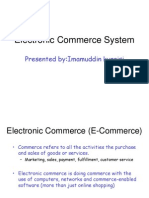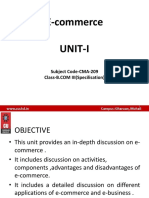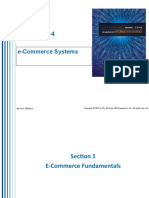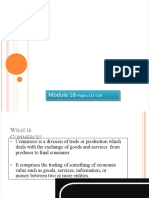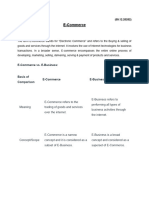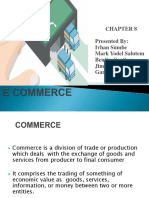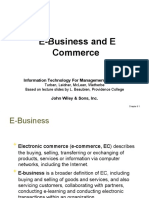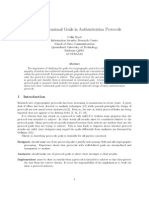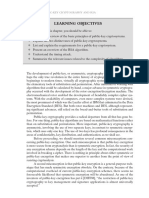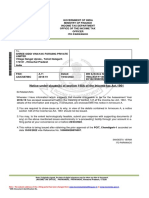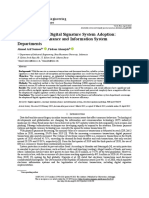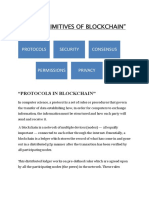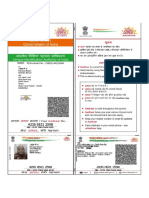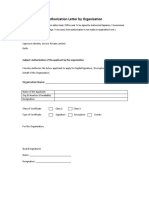Client
UPLOAD
Browse
DOWNLOAD
STANDARD VIEW
FULL VIEW
1
OF 26
2
E
Commerce
(BSCIT 6th
sem)
Ratings: (0)|Views: 127 |Likes: 1
Published by Rahul jordan
(BSCIT 6th sem)
See more
The client constitutes a personal
computer or a mobile device and a
browser, such as Internet Explorer
or Netscape Navigator for surfing the
Internet. The client forms the first tier
of e-commerce architecture.The
browser provides a Graphical User
Interface (GUI), which is the medium
through which the user interacts with
the server. The client then requests the
server to perform a specific task. It
receives thecontent from the server
and displays it to the user.
Middle-Tier
When a client requests for
information, the server retrieves it
from a storage location such as a
databaseor any other data source and
sends it back to the client. The server
acts as an intermediary layer
betweena client and a database,
and therefore, forms the middle-tier of
the technology domain. The
componentsof the middle tier are:
E-Commerce Architecture
The e-commerce architecture, when
explained with respect to
the technology, can be divided
into threelayers: client, middle-tier,
and back-end systems.
Application servers
Web servers
�Web services
Commerce servers
Server-side scripting languages
Back-End Systems
Databases form the third tier of the ecommerce architecture. The database
stores the details of all products and
services that are displayed on the web
page of an e-commerce website. It
also stores theinformation regarding
the customers such as customer
name, address, products ordered for,
mode of payment, and mode
of delivery.
Technology Domain
FAQs
Ans:
Encrypted e-mail is encrypted by the
sender's e-mail program, which
renders it unreadable until
therecipient decrypts it.
3.
What are electronic bulletin boards?
Ans:
Electronic bulletin boards are online
communication systems where one
can share, request, or
discussinformation on any topic. They
are also known as message boards or
computer forums.
E-Commerce Transaction
2.
E-commerce transaction is an
exchange that occurs when one
economic entity sells a product or
serviceto another entity over the
Internet. It takes place when a product
or service is transferred across
atechnologically separable interface
that links a customer with a producer.
E-commerce transactionfollows a
seven-step process that is as follows:
What is encrypted e-mail?
Step 1: Browsing for a Product
1.
What is market-link transaction?
Ans:
Market-link transaction is another
name for business-to-business
transactions.
�An e-commerce transaction begins
when a customer visits an ecommerce website. In this
step, thecustomer searches, discovers,
and compares one product with
another for purchase. At the end of
thisstep, a potential customer may be
tempted to buy products that are
on sale or on promotion. For
example,consider that you need to
buy a digital camera. You can
visit several websites that sell digital
cameras.You can then search for
detailed information about cameras on
all these websites and also compare
thefeatures of various models of
cameras sold over the same
or different websites.
Step 2: Identifying and Listing the
Products
In this step, the customer selects the
products, negotiates or determines
their total price, and then addsthem to
their shopping cart. The list consists
of products that the customer has
selected, their quantities, prices,
attributes, such as color and size, and
any other feature related to the
product. A customer canalways clear
the list, remove individual items from
it, and also update quantities of the
products.Continuing with the example
discussed in the previous step, in this
step, you add the digital camera
thatyou selected to your shopping
cart, which might already include
several other products.
Step 3: Placing the Order
When the customers complete
selecting the items for purchase from
an e-commerce site, they proceed
to place an order. The website
displays a form to the customers to
enter their personal details, shipping
and billing address information, and
the mode of delivery. It also allows
the customer to choose the
shippingmode. The customers might
also add some additional information
for ancillary services such as
gift,greeting, and gift-wrapping. In
this step, you place an order for the
digital camera. This includes filling
inthe registration and the order form.
You also need to specify the mode of
shipping.
Step 4: Confirming the Order
In this step, the e-commerce website
calculates the taxes and shipping
charges applicable to the productto be
delivered. Next, the order
is confirmed and the customer is
intimated about the total payment to
bemade for receiving the products.
The final cost is displayed to the
customer and the payment
�informationis requested. The validity
of the information entered by the
customer is then verified in
the background. If the information is
correct and acceptable, order
confirmations are created. Once the
verification is done,the order
is confirmed.
Step 5: Making the Payment
In this step, the customer makes the
payment for the products. The mode
of payment varies with the typeof
transaction. There are various modes
of payment such as credit cards,
electronic checks, and electroniccash.
creditcard information that you
specify for the payment of the digital
camera is verified with the help of a
third party, and if it is fine, the
purchase is approved.
Step 7: Processing the Order
The last step in an e-commerce
transaction is to process the order,
after which the products ordered by
thecustomer are delivered or shipped
by using the mode of delivery chosen.
FAQs
1.
What is OMC cycle?
Ans:
Step 6: Verifying and Approving
the Purchase
In this step, the mode of payment is
verified. Consider an example in
which a customer makes the payment
through a credit card. Now, the
validity of the credit card needs to be
verified. It is checkedwhether the
credit card account contains sufficient
funds and the number entered
is correct. Theauthorization of the
credit card is also verified. After
the verification is over, the business
websiteapproves the purchase of the
product and the customer is supplied
with a proof of payment. The
OMC cycle refers to the order-todelivery cycle from the merchants
perspective. It consists of eight
stepsnamely order planning and order
generation, cost estimation and
pricing, order receipt and entry,
order selection and prioritization,
order scheduling, order fulfillment
and delivery, order billing
andaccount/payment management,
and post-sales service.
2.
�List the phases involved in the
business process model from the
consumers perspective
.
Ans:
There are three phases in the business
process model from the consumers
perspective. They are asfollows:1.
Prepurchase determination
: It involves searching and
selecting a product after
comparing itsfeatures from various
sites.2.
Purchase consummation
: It involves placement of the order,
authorization of payment, and
receiptof payment.3.
Postpurchase interaction
: It involves providing feedback
to the e-commerce site based on
the purchase.
Digital Cash
Digital cash is the electronic
equivalent for currency. Digital cash
is either stored on the chip of a
smartcard or on the PC of a consumer.
Digital cash has gained popularity
with the increase in the volume
of electronic business. It combines
computerized convenience with
security and privacy. The versatility
of digital cash opens up a host of new
markets and applications.Digital Cash
is the leader in the electronic cash
system. It has implemented secure
transactions with theuse of
cryptography. Although it is
a software-based program, Digicash
requires the user to possess anaccount
with an online bank.Digital cash is
based on cryptographic systems called
digital signatures. This method uses
very largeintegers known as numeric
keys. These keys exist as a pair and
always work together, one for
encryptionor locking and the other
for decryption or unlocking. Only the
decryption key of the pair can
unlock whatever is locked by the
encryption key. The encryption key
remains private while the decryption
key ismade public. Banks provide
their buyers and sellers with
the public key. Therefore, the
customers candecode any currency
that has been encoded with the banks
private key.Digital cash can be
implemented by using the Wallet and
point-of-sale programs. Wallet is a
programthat stores digital cash. When
a wallet is used in a digital
transaction, both the buyer and the
seller need toimplement the same type
of wallet. This is because wallets
�do not follow a standard format. The
point-of-sale program integrates the
website, the wallet program of the
buyer, and the wallet program of the
seller.
This program also initiates the
transfer of funds between the buyer
and seller, validates, and logs
thetransaction.
Properties of Digital Cash
To act as an effective medium of
payment, digital cash must have the
following properties:
Monetary value
Interoperability
Accessibility
Security
Monetary value
: Digital cash must have a monetary
value. It must be supported by cash,
bank-authorized credit, or a bankcertified cashiers check. The creation
and acceptance of digital cash
betweenany two banks must take
place smoothly. A bank certification
is very important for digital cash
to bevalid. If there is no
bank certification, it could imply that
the customer who is making the
purchase doesnot have enough funds
in his or her account.
Interoperability
: Digital cash must be interoperable.
In other words, it should be possible
to exchangedigital cash with another
type of digital cash, goods, or
services. All the banks must
provide support for digital cash to
promote its use.
Accessibility
: People using digital cash should be
able to store it as well as withdraw it
whenever required. Digital cash can
be stored on a remote computer or
portable devices such as a Personal
DigitalAssistant (PDA) along with
proper security measures. There
should be a provision for an
authentication process, such as the use
of passwords.
Security
�: When digital cash is exchanged,
there should be no scope
for malpractices such as copying
or manipulating it. The security aspect
of digital cash should be able
to prevent or detect duplication
anddouble spending. Sometimes, a
consumer might use the same digital
cash simultaneously for carrying
outtransactions in different countries.
This is an instance of double
spending.
Electronic Wallet
An electronic wallet serves a function
similar to a physical wallet. It holds
credit cards, electronic cash,owner
identification, and owner contact
information. Some electronic wallets
also contain an address book.
addition, digital certificates are used
to authenticate the payers, their banks,
and their accounts. Digital checks that
use digital signatures implement
cryptography to maintain the security
andauthenticity of digital
checks.Electronic checks facilitate
online services in the following ways:
The seller can verify the validity
of the available funds at the buyers
bank.
Security is enhanced at every
stage of the transaction process
through automatic validation of
theelectronic signature by the seller
and the bank.
Electronic Checks
The electronic check, also known as
digital check, is an electronic
document containing information
likename of the payer, his/her account
number, the name of the bank, the
name of the payee, and the amountto
be transferred. It has a digital
signature equivalent to the signature
on a traditional check.Electronic
checks are the same as paper checks
except that digital signatures are used
for signing andapproving them. In
The EDI-based electronic transaction
facilitates payment integration.
Electronic checks are transferred
through direct telephone lines or the
Internet. These payments arecollected
by the banks and cleared through their
networks.
Processing of Electronic Checks
�The steps involved in the processing
of electronic checks are:
1.The electronic check users
register with a third-party
accounts server before they are
able towrite electronic checks. For
example, Jack wants to transact with
IBG, Inc. by using electronicchecks.
To be able to do this, Jack first needs
to register with a third party.2.After
the registration process is
complete, a consumer can contact
a seller to buy products
or services. Consumers send an
electronic check to the seller by using
e-mail. For example, after registering,
Jack can make an online purchase
from IBG Inc.3.After the electronic
check is deposited, funds are
transferred from the account of
the buyer tothat of the seller. For
example, when the electronic check
signed by Jack is deposited, the
third party makes the payment to IBG,
Inc. by withdrawing funds
from Jacks account.
Authentication
: It ensures that the credit
card accepted from the customer is
valid, has actually beenissued, and is
not reported stolen.
Authorization
: It ensures that the card has sufficient
credit available for the purchase. If
the card hass u f f i c i e n t c r e d i t ,
t h e c r e d i t l i mi t of t h e c u s t o me
r i s t e mp o r a r i l y r e d u c e d b y t h
e v a l u e o f t h e transaction.
Authorization can be obtained in the
following ways:
Manual
: The storeowner downloads the
details of the transaction from the web
server, and thenrequests authorization
by using various methods such as
a point of sale (POS) terminal or
a personal computer (PC) program.
Credit Card
Automatic
The following processes take place
during a credit card transaction:
: The server obtains online
authorization by communicating
directly with thecomputer of the credit
card processing company. Although
�automatic authorization is
mostly preferred, it is more complex
and costly.
Settlement
: Once the products are shipped or
delivered to the customers, the
company informs
the banks by issuing a capture request,
which is a request for settlement. The
banks then release the previously rese
rved funds, and the money is transferr
ed to the account of the company thro
ughnumerous banks
and intermediaries.Security plays a
very important role when using credit
cards for online transactions. Many
companieshave offered various
software, such as iAuthorizer by
Atomic Software, for conducting
a securetransaction while using credit
cards.Several vendors have developed
software for both the sellers and the
banks. The software allows thesellers
to buy a single package integrated
with the Web server. This
combination serves as an
electronicstore and a payment system.
The buyers interact with the store to
purchase any product by
using their own browser. The
software allows the banks to use their
computer systems for verifying and
processingthe encrypted credit
card information.The credit card
payment process involves two
steps:1 . S e l l e r s p r o v i d e t h e
b u ye r wi t h t h e p r o d u c t
o r s e r v i c e p r i c e , c o n f i r ma t i o n
o f o r d e r , s t a t u s , delivery process,
and payment options.2 .Th e b u y e r s
p r o v i d e t h e s e l l e r wi t h t h e
p a yme n t c h o i c e a n d o t h e r
e s s e n t i a l i n f o r ma t i o n i n
a secured way.
Activity (2)
FILTERS
Add to collectionReviewAdd
NoteLike
1 hundred reads
suresh1776job liked this
Similar to E
Commerce(BSCIT 6th
sem)
Basics of .NET(BSCIT 6th sem)
RAHUL JORDAN
�ASHWIN KUMAR
Advance Computer
Networks(BSCIT 6th sem)
RAHUL JORDAN
BSIT-64 (Part-TA)
AM_EHSAAS
Computer Ethics and Cyber
Laws(BSCIT 6th sem)
RAHUL JORDAN
More From This User
Computer Ethics and Cyber
Laws(BSCIT 6th sem)
RAHUL JORDAN
E-COMMERCE
ASHWIN KUMAR
Basics of .NET(BSCIT 6th sem)
RAHUL JORDAN
Basics of .NET
MANISH KUMAR
Advance Computer
Networks(BSCIT 6th sem)
RAHUL JORDAN
BASICS OF .NET
�RAHUL JORDAN
Understanding Tcpip
RAHUL JORDAN
Graphics and Multimedia
RAHUL JORDAN
Security
RAHUL JORDAN
Data Warehousing and Data
Mining
RAHUL JORDAN
Photoshop 6
RAHUL JORDAN
Software Quality and Testing
RAHUL JORDAN
ASP Beggener
RAHUL JORDAN
Web Programming
RAHUL JORDAN
09 Communicating
Download and print this document
Rahul jordan
Read and print without ads
Download to keep your version
Edit, email or read offline
(BSCIT 6th sem)
Choose a format:
.DOC
E-COMMERCE
.PDF
Ashwin Kumar
DOWNLOAD
Previous|NextPage 1 of 2
Recommended
.DOC
.PDF
DOWNLOAD
ABOUT
Basics of .NET(BSCIT 6th sem)
Rahul jordan
(BSCIT 6th sem)
Advance Computer
Networks(BSCIT 6th sem)
SUBSCRIPTIONS
Rahul jordan
Browse books
Browse documents
About Scribd
Team
Blog
Join our team!
Contact Us
(BSCIT 6th sem)
Subscribe today
Your subscription
Gifts
ADVERTISE WITH US
AdChoices
SUPPORT
Computer Ethics and Cyber
Laws(BSCIT ...
Help
FAQ
Press
Purchase help
PARTNERS
Publishers
Developers / API
LEGAL
Terms
Privacy
Copyright
Copyright 2014 Scribd Inc.
Mobile Site
Language:
English


